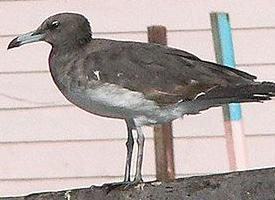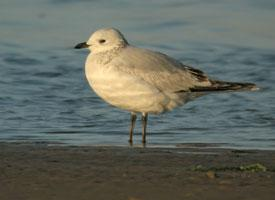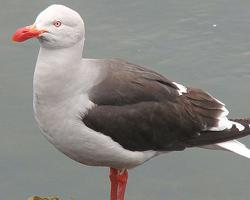
Stav ohrožení
| Ohrožen |
Popis zvířete
The Sooty Gull, scientifically named Ichthyaetus hemprichii, is a captivating bird species that is part of the Laridae family, which encompasses gulls, terns, and skimmers. This medium-sized gull species exhibits a distinctive appearance and behavior that makes it an interesting subject of study for ornithologists and bird watchers alike.Physical Description:
The Sooty Gull stands out with its sleek, sooty-grey plumage, which covers most of its body, lending it its common name. Adults typically feature a darker, almost black head during the breeding season, which contrasts strikingly with their white eyes. The bird's bill is robust and slightly hooked at the end, displaying a vivid red or orange color that adds a splash of brightness to its otherwise muted tones. Its legs and feet are a similar shade of red or orange, creating a cohesive and striking appearance.
Juveniles and non-breeding adults have a mottled appearance with lighter grey and white plumage, making them somewhat less distinctive than their fully mature counterparts. However, they still retain the characteristic bill and leg colors, which can help in their identification.
Size and Wingspan:
The Sooty Gull is considered a medium-sized gull, with an average length ranging from 40 to 46 centimeters (16 to 18 inches) and a wingspan that extends about 105 to 115 centimeters (41 to 45 inches). This size allows it to be agile in flight while still possessing the strength necessary for its scavenging and hunting lifestyle.
Habitat and Distribution:
This species is primarily found along the coasts and islands of the Red Sea and the Gulf of Aden, extending its range to parts of the Arabian Sea. It prefers coastal environments, including sandy beaches, rocky shores, and mudflats, where it can forage for food. The Sooty Gull is somewhat of a regional specialist, with a distribution that is closely tied to the warmer waters of its range.
Diet and Behavior:
The diet of the Sooty Gull is varied and opportunistic, consisting of fish, crustaceans, insects, and even the eggs and young of other bird species. This gull is also known to scavenge, taking advantage of carrion and human refuse, which sometimes brings it into conflict with people. Its foraging behavior is versatile, including diving from the air into the water, picking food off the surface of the sea, or even stealing prey from other birds.
Reproduction:
Sooty Gulls are colonial nesters, often forming large breeding colonies on isolated beaches and islands. The nesting season is closely tied to their specific habitat, with most breeding activities taking place during the spring and early summer. Nests are typically simple scrapes in the ground, lined with vegetation and feathers. A typical clutch consists of two to three eggs, which are incubated by both parents. The chicks are semi-precocial, able to move around shortly after hatching but still reliant on their parents for food and protection.
Conservation Status:
Currently, the Sooty Gull is not considered to be at a significant risk, with a stable population and a wide range. However, like many seabird species, it faces threats from habitat destruction, pollution, and human disturbance, particularly in its breeding areas. Conservation efforts aimed at protecting its natural habitats and mitigating human impacts are crucial for ensuring the continued survival of this unique gull species.
In summary, the Sooty Gull (Ichthyaetus hemprichii) is a fascinating bird that plays an important role in the coastal ecosystems of its range. Its distinctive appearance, interesting behaviors, and the challenges it faces make it a significant species for conservationists and bird enthusiasts alike.
Podobná zvířata
Nové fotografie zvířat
Top 10 zvířat
- Elephant hawk moth (Deilephila elpenor)
- Common house mosquito (Culex pipiens)
- Common cockchafer (Melolontha melolontha)
- Australian box jelly (Chironex fleckeri)
- Fruit fly (Drosophila melanogaster)
- Colossal squid (Mesonychoteuthis hamiltoni)
- Wasp spider (Argiope bruennichi)
- Moustached guenon (Cercopithecus cephus)
- Diana monkey (Cercopithecus diana)
- Sea urchins (Echinoidea)


